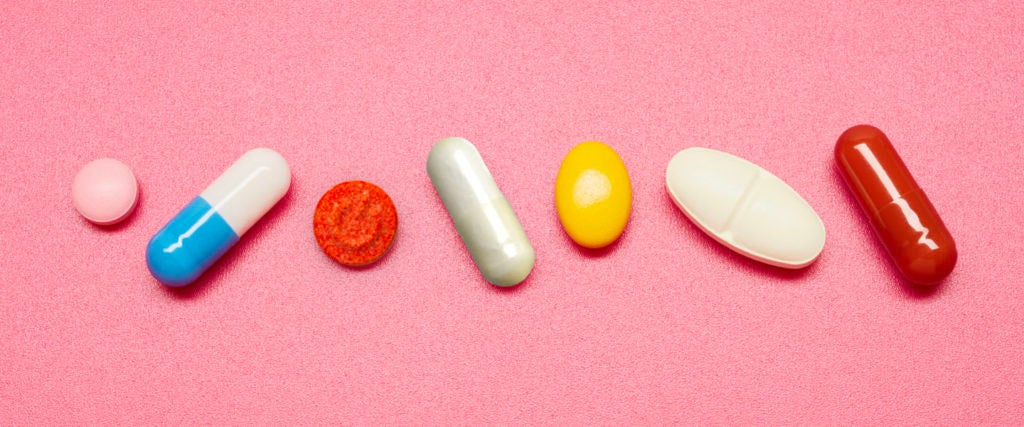Though they have similar serotonin-boosting effects, MDMA and SSRIs conjure up near-opposite images. The former invokes memories of you shaking that thang at a music festival while the latter serves as a reminder of when you lost your sex drive while going through a rough patch. But as research suggests, they’re surprisingly alike, and they may even be comparable in their capacity to treat the same ailments, like PTSD and depression. Here’s what you need to know about their parallels, including why you should never take both at the same time.
Are MDMA and SSRIs chemically similar?
Not quite, but they have some overlapping effects on the brain. “MDMA is a substituted phenethylamine that both inhibits presynaptic serotonin reuptake transporters and also causes the release of monoamine neurotransmitters, like serotonin,” explains psychiatric pharmacist Kelan Thomas, lead trainer at Fluence, a psychedelic therapy training company. “Selective serotonin reuptake inhibitors (SSRIs) are a class of antidepressants that have more variable chemical structures and share the same mechanism of action by inhibiting presynaptic serotonin reuptake transporters.”
In other words, both MDMA and SSRIs increase the levels of serotonin in your brain. This is believed to increase happy feelings, reduce anxiety and generally improve your mood. They both do so by blocking the reuptake of serotonin, but unlike SSRIs, MDMA also prompts your body to produce more of it.
There are some serious distinctions between the two drugs, though. “As a substituted amphetamine, MDMA also increases other monoamine neurotransmitters like norepinephrine and dopamine, which leads to more acute adverse effects like increased blood pressure and heart rate,” Thomas explains. It’s the norepinephrine and dopamine that are believed to produce those feelings of euphoria and wanting to smooch everyone in a mile radius.
That’s why MDMA makes you almost immediately jovial, whereas SSRIs take a much slower approach at increasing your overall contentment.
Why is MDMA suddenly being researched as an SSRI alternative?
In part because SSRIs aren’t doing a great job, at least seemingly. While it’s admittedly challenging to study antidepressants — patients may get better on their own, and not all depressions (or other mental conditions) are alike — some studies have suggested that SSRIs aren’t much more effective than placebos, or at least have another mechanism besides blocking serotonin reuptake.
“I’ve prescribed SSRIs for nearly 20 years,” says psychiatrist Sue Sisley, who’s in the Multidisciplinary Association for Psychedelic Studies MDMA Therapy Training Program. “They’re disappointing. These prescriptions often take many months to show any clinical effect. For too many patients, when they do take hold, the therapeutic benefit is very anemic: They may have some symptom control of the depression or anxiety that come along with PTSD, but they can be plagued with side effects from the daily medication.”
There have been plenty of studies that aim to dispel those doubts, and things look much better for SSRIs when they’re combined with therapy. Likewise, a 2020 analysis found that in studies involving adults with moderate to severe depression, “about 40 to 60 out of 100 people who took an antidepressant noticed an improvement in their symptoms within six to eight weeks.” Still, the other 40 percent who didn’t respond to traditional SSRIs — or worse, responded poorly — highlight the need for an alternative. And that’s why we’re looking into MDMA.
There’s still much research to be done on MDMA as a therapy for psychological disorders, but the latest clinical trials suggest that PTSD symptoms can be reduced to the point where patients no longer meet the PTSD criteria after just “two to three active doses of MDMA” accompanied by non-drug therapy sessions. Interestingly, the doses employed in the studies — 75 to 125 milligrams — are analogous to recreational doses, though it’s safe to assume that MDMA provided in clinical settings has been more thoroughly tested for purity than whatever you’ve nabbed from some guy at the bar. It’s no miracle, though: As the report on one of those same clinical trials concedes, “A minority [8.4 percent] reported harms from study participation.” Still, only 3.1 percent said those harms, including a worsened mood, were present come their 12-month follow-up, and “all participants who reported harm also reported at least one benefit.”
“I view the current FDA-approved prescriptions, like Zoloft and Paxil, as a Band-Aid approach,” says Sisley. “With MDMA-assisted therapy, participants are actually addressing the root problem: Trying to process the trauma. For many, it catalyzes people’s own ability to close that awful chapter of their life.” In other words, MDMA-assisted therapy seems to work much like how other psychedelic-assisted therapies seem to work. But again, that’s just the early implication.
If I take both at once will they eradicate my depression?
No! Taking the two together will cancel out their effects. “These medications are both competing for serotonin reuptake transporters, which substantially decreases the subjective effects of MDMA and also attenuates the increased heart rate and blood pressure caused by MDMA ingestion,” Thomas says. There have also been case reports in which MDMA and SSRIs taken together result in serotonin syndrome, a potentially life-threatening accumulation of serotonin in the body.
For these reasons, patients undergoing MDMA-assisted therapy are told to taper their SSRI usage prior to undergoing treatment, although there’s debate over how long that tapering process should last (longer appears to be better). Not to mention, symptoms of SSRI withdrawal, like anxiety and mood swings, can muddy the waters of MDMA-assisted therapy and make evaluating a patient after their sessions extra strenuous.
Who would have thought the same drug that made you grind a stranger during a Skrillex set would one day compete with SSRIs for the prize of healing our minds?

